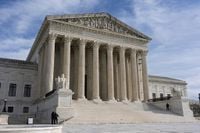The U.S. Supreme Court on October 15, 2025, found itself at the epicenter of a legal battle that could dramatically reshape the landscape of voting rights in America. At stake in Callais v. Louisiana is nothing less than the future of Section 2 of the Voting Rights Act of 1965—the very provision designed to guard against racial discrimination in how elections are run and maps are drawn. With justices signaling a willingness to take a bold swing at this foundational law, the case has sparked alarm, hope, and fierce debate across the nation.
The origins of this high-stakes dispute trace back to Louisiana’s congressional redistricting after the 2020 census. In 2022, the state legislature drew a map with only one majority-Black district, despite Black residents accounting for about a third of the population. This move prompted Black voters to sue, arguing that the plan diluted their voting power and violated Section 2, which prohibits racial discrimination in voting practices. Lower courts sided with the plaintiffs, ruling that the map failed to reflect the state’s demographics and ordering lawmakers to create a second majority-Black district.
Louisiana’s response was swift. To avoid a court-imposed map, legislators passed a new plan that added the required second majority-Black district. Yet, this remedy sparked a fresh lawsuit—this time from non-Black plaintiffs who claimed the revised map discriminated against them on the basis of race. The legal wrangling set the stage for the Supreme Court to weigh in on a question with far-reaching consequences: Can race be considered in redistricting remedies, and if so, to what extent?
Wednesday’s oral arguments were anything but routine. The Supreme Court, which had already heard the case in March 2025, decided to revisit it with a different and even more pointed question. The justices, led by Chief Justice John Roberts and Justice Brett Kavanaugh, probed whether the intentional creation of a second majority-minority district in Louisiana violated the 14th or 15th Amendments—constitutional provisions that bar the government from denying or restricting voting rights based on race. The Associated Press reported that Roberts and Kavanaugh expressed skepticism about the indefinite justification for race-based districts, signaling a potential willingness to narrow or even end the protections offered by Section 2.
Janai Nelson, president and director-counsel of the NAACP Legal Defense Fund, took the unusual step of personally arguing the case before the high court. “This case is so important. It is such a pivotal moment potentially for our multiracial democracy that I felt it was necessary for us to commit every possible resource to this fight. And that included me being part of it,” Nelson told Slate. She described the stakes as nothing less than the future of American democracy, noting that the Voting Rights Act is “the birth certificate of our democracy.”
During the nearly three-hour session, justices wrestled with the core issue: whether courts can or should use race as a factor when remedying voting rights violations. According to Slate, Justice Neil Gorsuch pressed Nelson on whether it is “acceptable under Section 2, as you understand it, for a court to intentionally discriminate in a remedial map on the basis of race?” Nelson countered that the text of the statute and the 14th and 15th Amendments explicitly address racial discrimination and that race is inherently part of the calculus when remedying past injustices.
Yet, the court’s conservative majority seemed to entertain the idea of a “sell-by date” for racially remedial measures—a notion championed by Justice Kavanaugh. He posited that, at some point, such measures should expire. Nelson pushed back, arguing, “There’s absolutely nothing that says that must happen. And in fact, I can’t really point to any statutes that I’m aware of where the court has taken that action recently. So to single out the Voting Rights Act, which the court has held is the crown jewel of civil rights legislation, is absolutely shocking.” She emphasized that Congress, not the court, should decide if and when such protections are no longer needed.
The case also prompted discussion of legal precedent. Allen v. Milligan, decided by the Supreme Court just 28 months prior, upheld Section 2’s protections in circumstances nearly identical to those in Louisiana. Thornburg v. Gingles, the 1986 case that established the current framework for evaluating racial discrimination in redistricting, also loomed large. Yet, several justices appeared open to revisiting, or even discarding, these precedents. “It was disturbing to see justices of the Supreme Court also engaging in that colloquy of how do we just abandon a case from 1986?” Nelson remarked to Slate.
The implications of the court’s decision could be sweeping. As the Associated Press noted, a ruling that narrows or invalidates Section 2 could give states greater leeway to draw political maps without regard for racial impacts—potentially diminishing minority representation not only in Louisiana but across the country. Legal experts warn that the ripple effects could extend to other arenas, such as housing and employment, where race-based protections have long been enshrined in federal law.
The timing of the decision is also critical. Attorneys involved in the case urged the court to rule in time for new congressional maps to be drawn ahead of the 2026 midterm elections. Depending on the outcome, other states—especially in the South—could launch new redistricting efforts, further shifting the political balance.
For many observers, the court’s willingness to revisit settled law is cause for concern. Justice Elena Kagan pointedly asked how the court could justify upending recent and detailed precedent from Allen v. Milligan. Nelson echoed this sentiment, stating, “The court had already decided a lot of these issues. They challenged the constitutionality of Section 2, which has been decided many times and is on very firm footing constitutionally, and the court said, No, that goes against decades of our precedent.”
Yet, not all justices are on the same page. While Kavanaugh’s interest in a “sell-by date” is clear, he has also been a vocal defender of stare decisis—the principle that courts should adhere to precedent—and the separation of powers. Nelson pointed out that when Congress wanted to limit parts of the Voting Rights Act, such as Section 5, it did so explicitly, requiring periodic reauthorization. Section 2, by contrast, was never given an expiration date.
As the justices deliberate, the nation waits. The Supreme Court’s decision, expected before the end of its current term in June, could either reaffirm longstanding protections for minority voters or mark a dramatic shift toward a race-neutral approach in redistricting. Either way, the outcome will reverberate far beyond Louisiana, shaping the future of American democracy for years to come.

